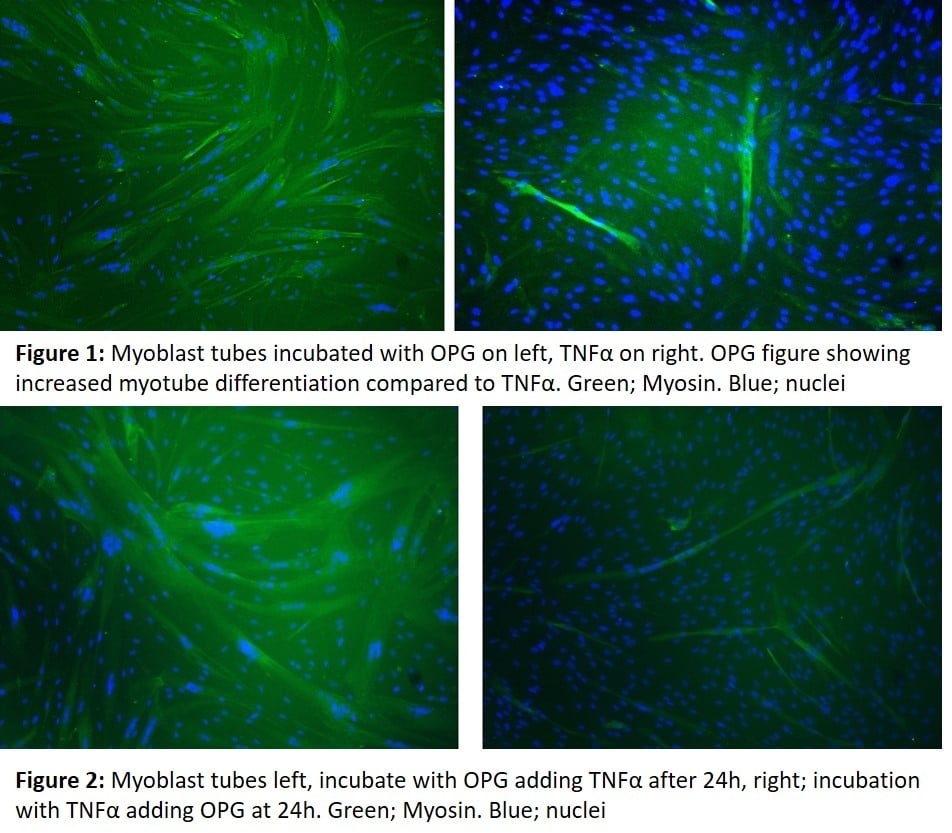Purpose: The present study was designed to, firstly, investigate the relationship between whole-body lean mass (WB Lean mass) and levels of circulating factors that have established roles in bone remodelling during ‘healthy’ ageing (Coulson et al., 2017). Then, secondly, investigate the potential protective effects of Osteoprotegerin (OPG) against TNFa exposure, which is known to induce apoptosis (Saini et al., 2008). Methods: WB Lean mass and fasting plasma concentrations of dickkopf-1 (DKK1), osteocalcin (OC), osteoprotegerin (OPG), osteopontin (OPN), sclerostin and tumour necrosis factor-alpha (TNFa) were measured in 272 older adults (aged 69 to 81 years; 52% were female) and 171 younger adults (18-30 years; 53% were female). Spearman’s rho partial correlations and multivariate regression were used to examine the relationships between lean mass and the circulating factors. Human myoblast cells were cultured with TNFa alone, OPG alone and both molecules combined. Myoblast differentiation parameters including aspect ratio, fusion index (%) and myotube area (%) were calculated. OPG concentration was measured in cell supernatants and selected ‘myokines’ were measured from supernatants of myoblasts exposed to TNFa. Results: WB Lean mass was 5% lower in old than young. Circulating osteocalcin was lower in old compared with young, while dickkopf-1, osteoprotegerin, sclerostin and TNFa were higher in old compared with young. These circulating factors were each significantly (p<0.03) negatively associated with WB Lean mass in the older adults, (OC; r=-0.175, DKK1; r=-0.312, OPG; r=-0.170, Sclerostin; r=-0.235) apart from TNFa that was positively associated (r=0.140) with WB Lean mass in older adults. In multivariate regression, height and OPG accounted for 45% of the WB Lean mass in the older adults. In young, the same combination of OPG and height accounted for 18% of variation in WBMD. Differentiation parameters (Figures 1 and 2) showed a significantly greater proportion of differentiation when OPG was added to the cultured myoblasts before TNFa (p<0.0001). ELISA showed significant secretion of OPG released from human myoblast cells, particularly during the first 24h of incubation (p=0.001) with an interaction effect found between TNFa and time F;(15,24) 3.340, p=0.004. Conclusion: These results identify OPG as a circulating factor significantly associated with whole body lean mass in young and older adults. OPG may also protect myoblasts against TNFa exposure and may therefore be a therapeutic target for intervention against inflammation associated with ageing and, ultimately, reducing the ageing decline of muscle loss.
Physiology 2019 (Aberdeen, UK) (2019) Proc Physiol Soc 43, PC093
Poster Communications: Osteoprotegerin (OPG) as a potential therapeutic target to combat inflammation associated with ageing and other comorbidities.
J. Piasecki1, N. Al-Shanti2, J. McPhee2
1. Sport Science, Nottingham Trent University, Nottingham, United Kingdom. 2. Department of Sport and Exercise Sciences, Manchester Metropolitan University, Manchester, United Kingdom.
View other abstracts by:
Where applicable, experiments conform with Society ethical requirements.

